Abstract
OBJECTIVE: The authors evaluated gas exchange, pulmonary function, and lung histology during perfluorocarbon liquid ventilation (LV) when compared with gas ventilation (GV) in the setting of severe respiratory failure. BACKGROUND: The efficacy of LV in the setting of respiratory failure has been evaluated in premature animals with surfactant deficiency. However, very little work has been performed in evaluating the efficacy of LV in older animal models of the adult respiratory distress syndrome (ARDS). METHODS: A stable model of lung injury was induced in 12 young sheep weighing 16.4 +/- 3.0 kg using right atrial injection of 0.07 mL/kg of oleic acid followed by saline pulmonary lavage and bijugular venovenous extracorporeal life support (ECLS). For the first 30 minutes on ECLS, all animals were ventilated with gas. Animals were then ventilated with either 15 mL/kg gas (GV, n = 6) or perflubron ([PFC], LV, n = 6) over the ensuing 2.5 hours. Subsequently, ECLS was discontinued in five of the GV animals and five of the LV animals, and GV or LV continued for 1 hour or until death. MAIN FINDINGS: Physiologic shunt (Qps/Qt) was significantly reduced in the LV animals when compared with the GV animals (LV = 31 +/- 10%; GV = 93 +/- 4%; p < 0.001) after 3 hours of ECLS. At the same time point, pulmonary compliance (CT) was significantly increased in the LV group when compared with the GV group (LV = 1.04 +/- 0.19 mL/cm H2O/kg; GV = 0.41 +/- 0.02 mL/cm H2O/kg; p < 0.001). In addition, the ECLS flow rate required to maintain the PaO2 in the 50- to 80-mm Hg range was substantially and significantly lower in the LV group when compared with that of the GV group (LV = 14 +/- 5 mL/kg/min; GV = 87 +/- 15 mL/kg/min; p < 0.001). All of the GV animals died after discontinuation of ECLS, whereas all the LV animals demonstrated effective gas exchange without extracorporeal support for 1 hour (p < 0.01). Lung biopsy light microscopy demonstrated a marked reduction in alveolar hemorrhage, lung fluid accumulation, and inflammatory infiltration in the LV group when compared with the GV animals. CONCLUSION: In a model of severe respiratory failure, LV improves pulmonary gas exchange and compliance with an associated reduction in alveolar hemorrhage, edema, and inflammatory infiltrate.
Full text
PDF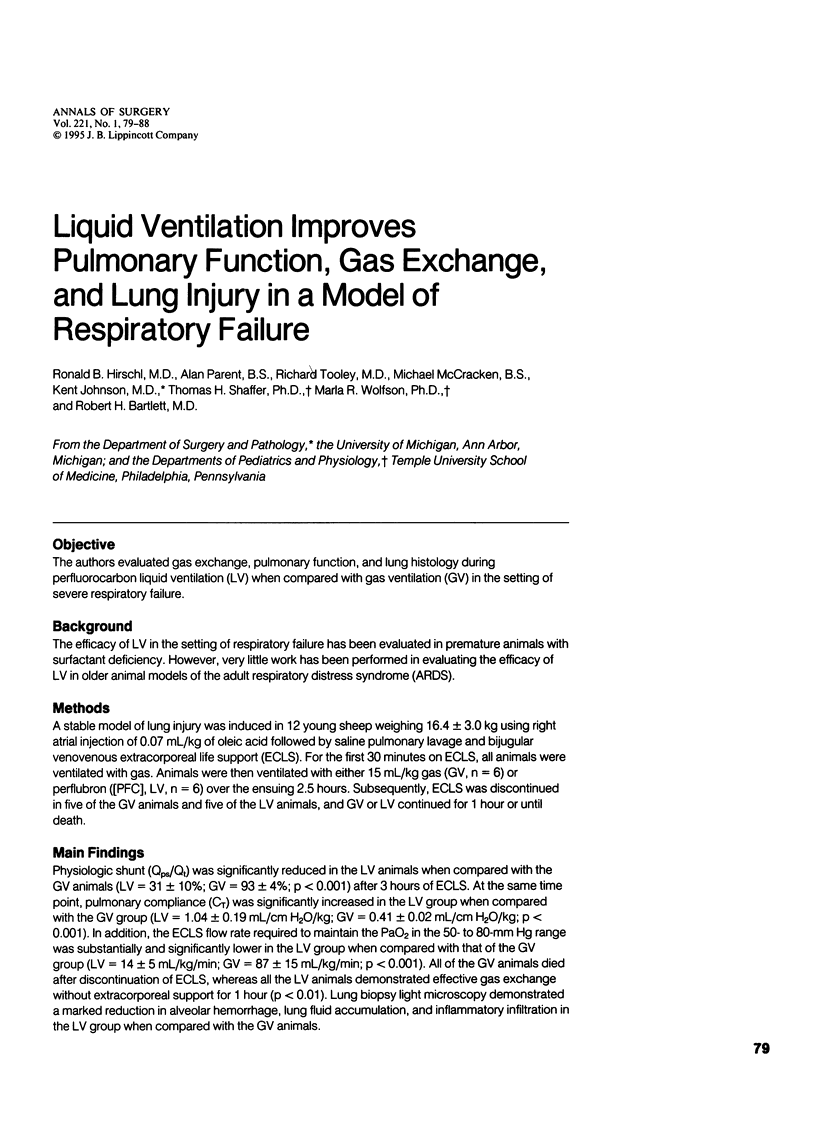
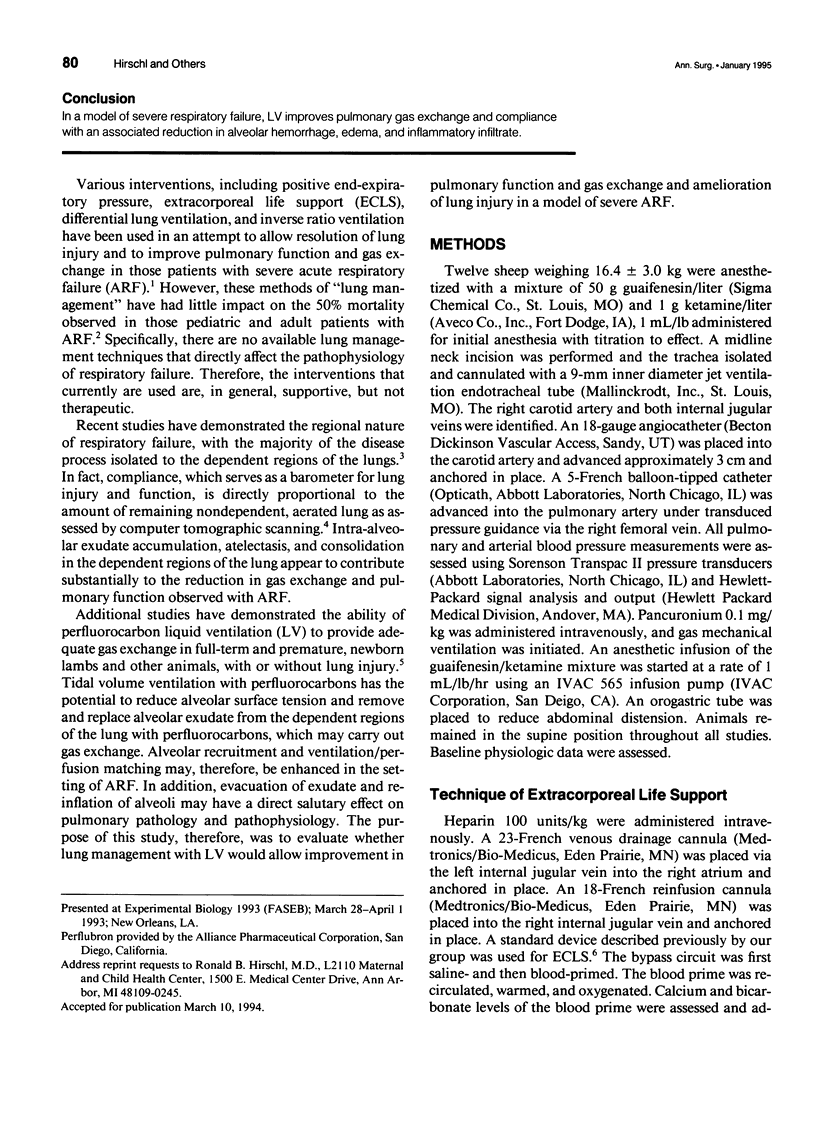
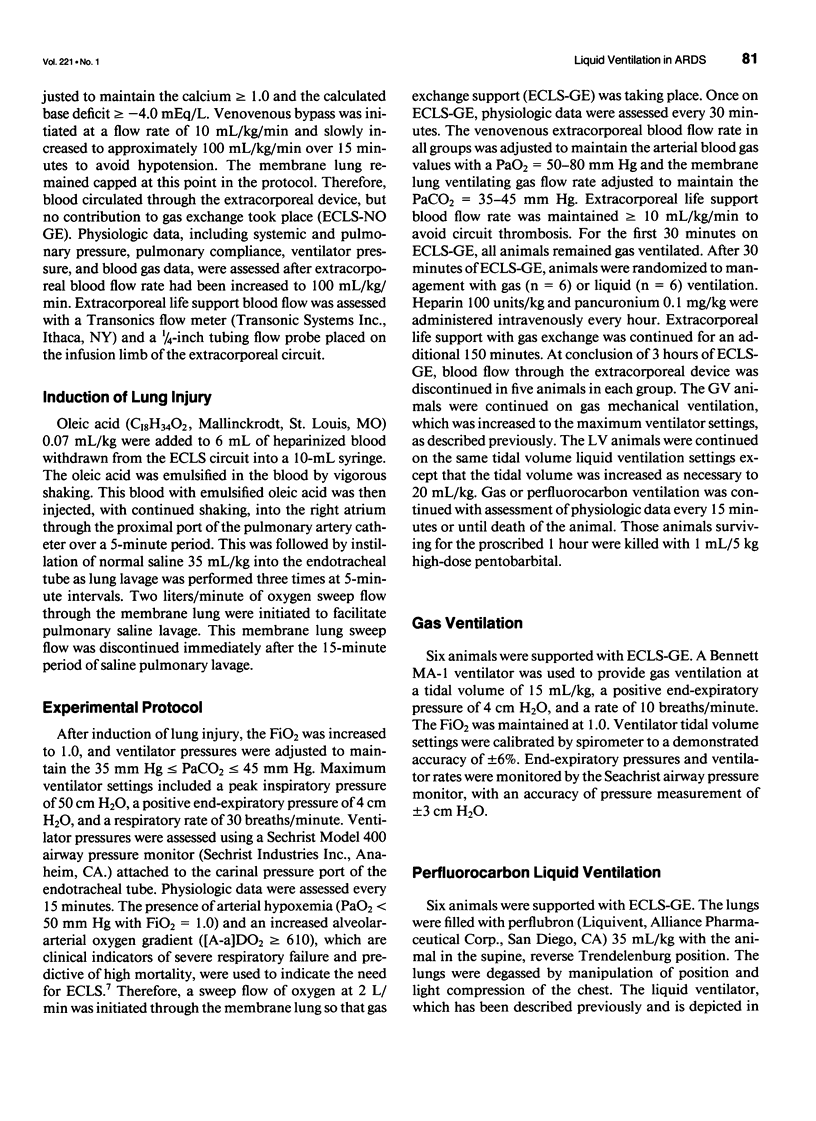
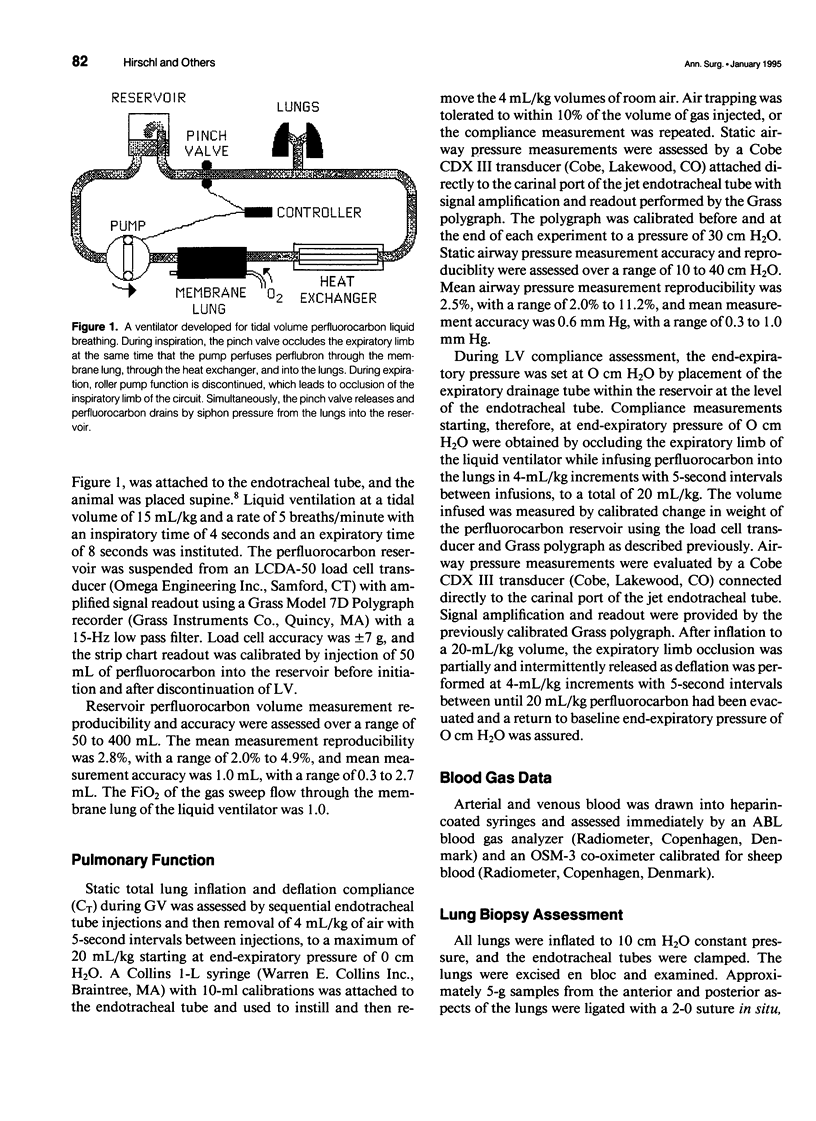
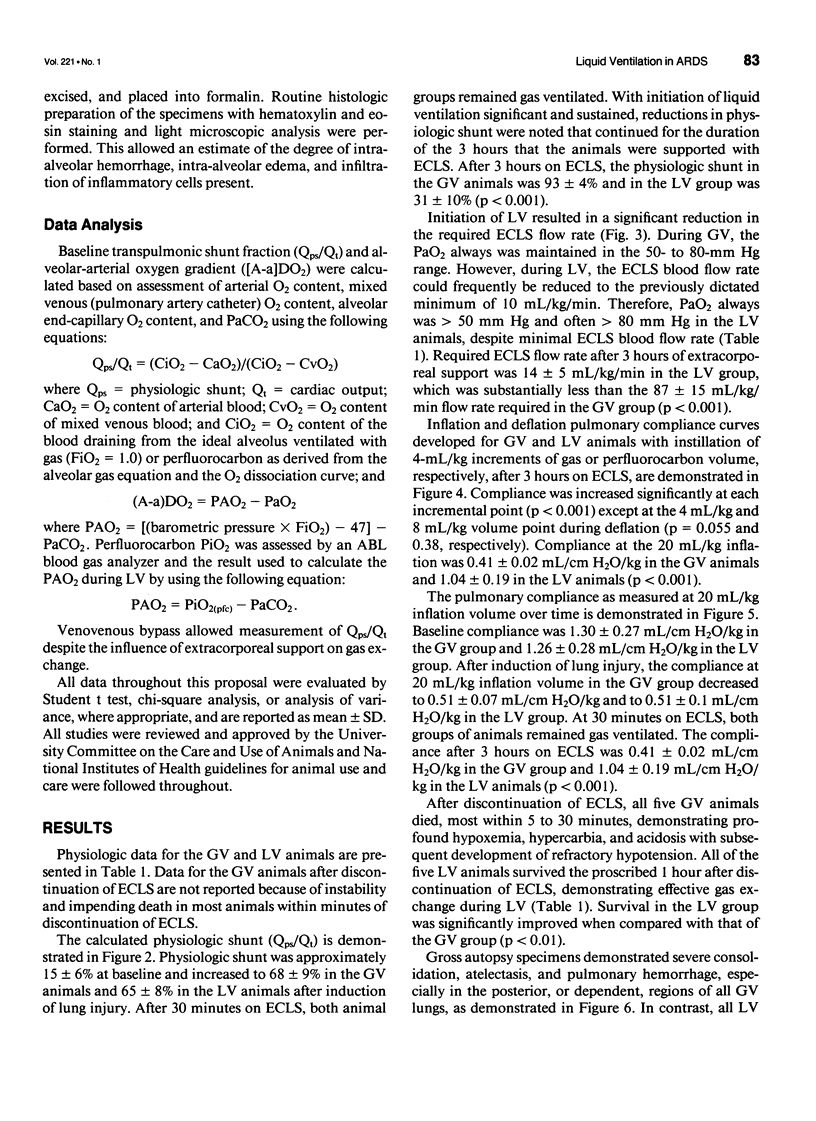
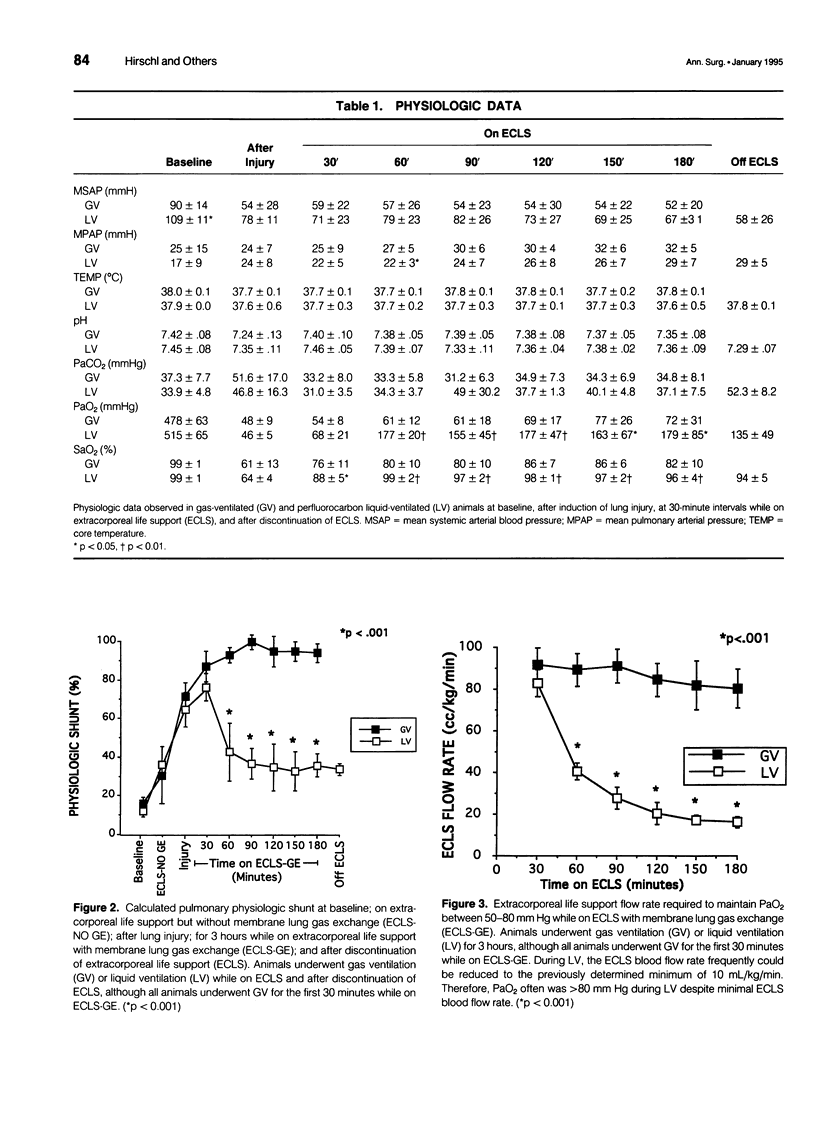
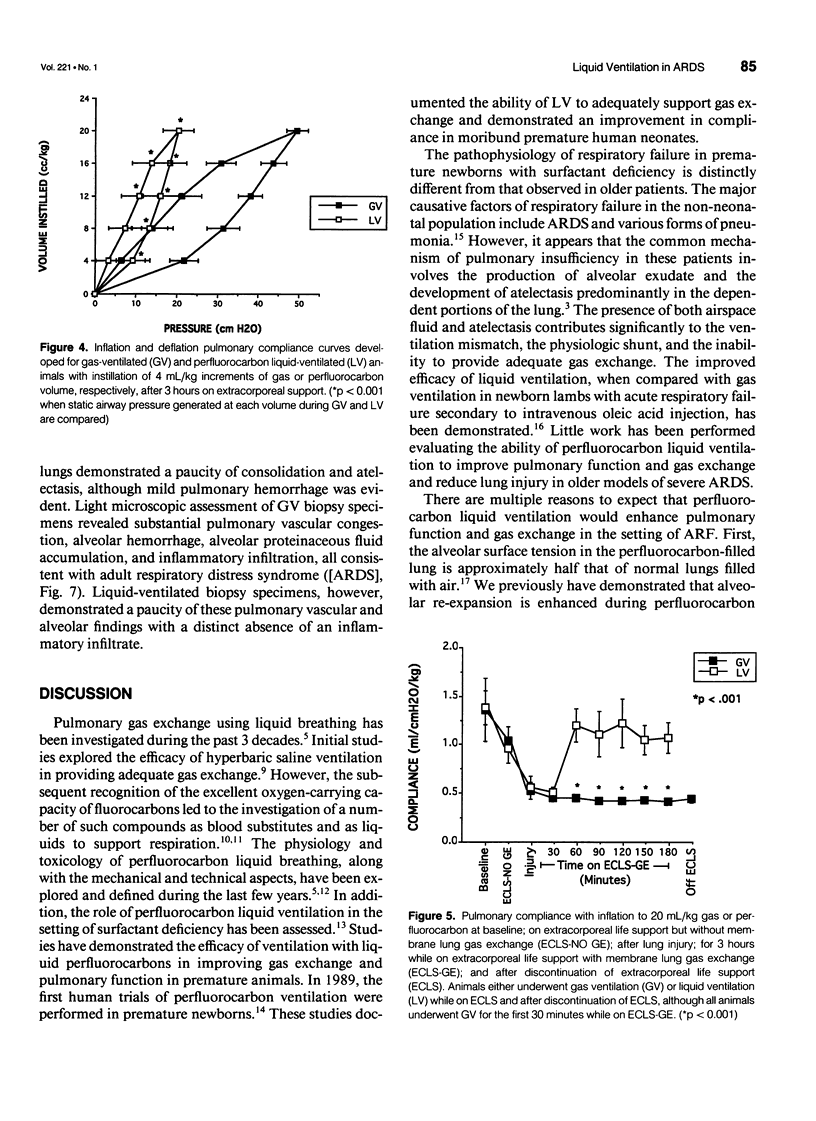
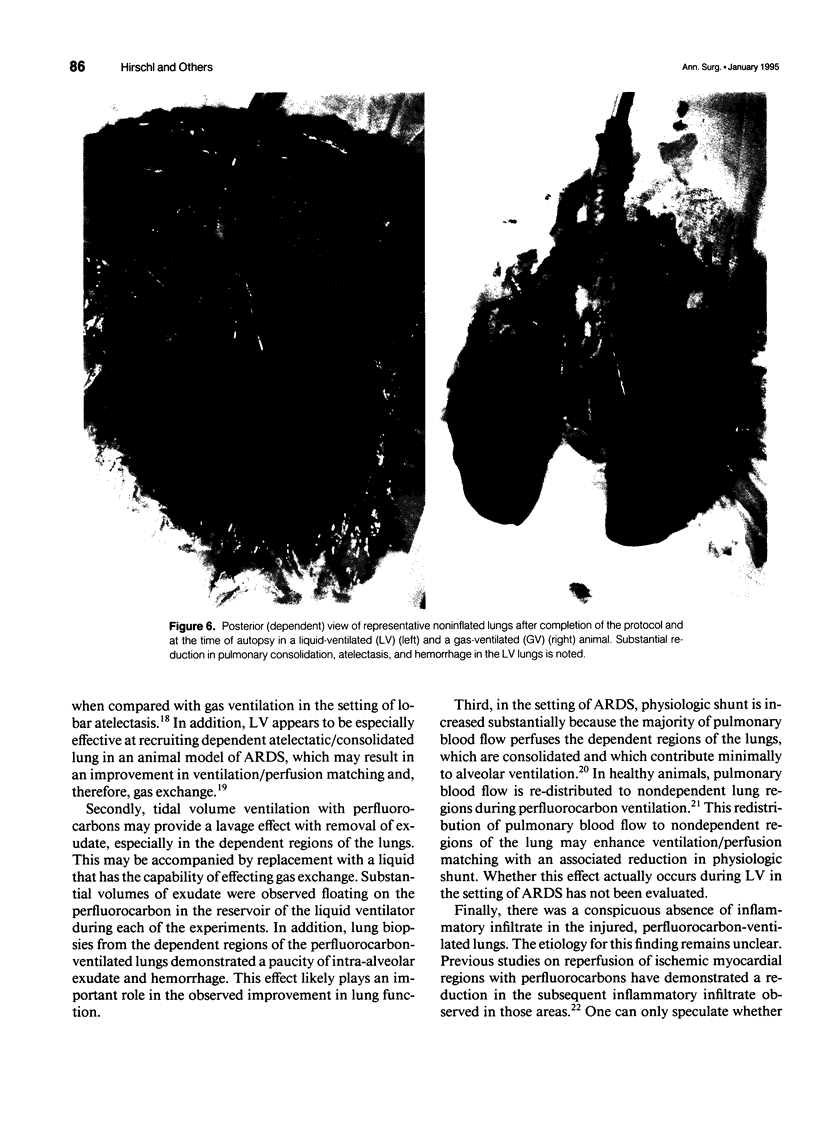
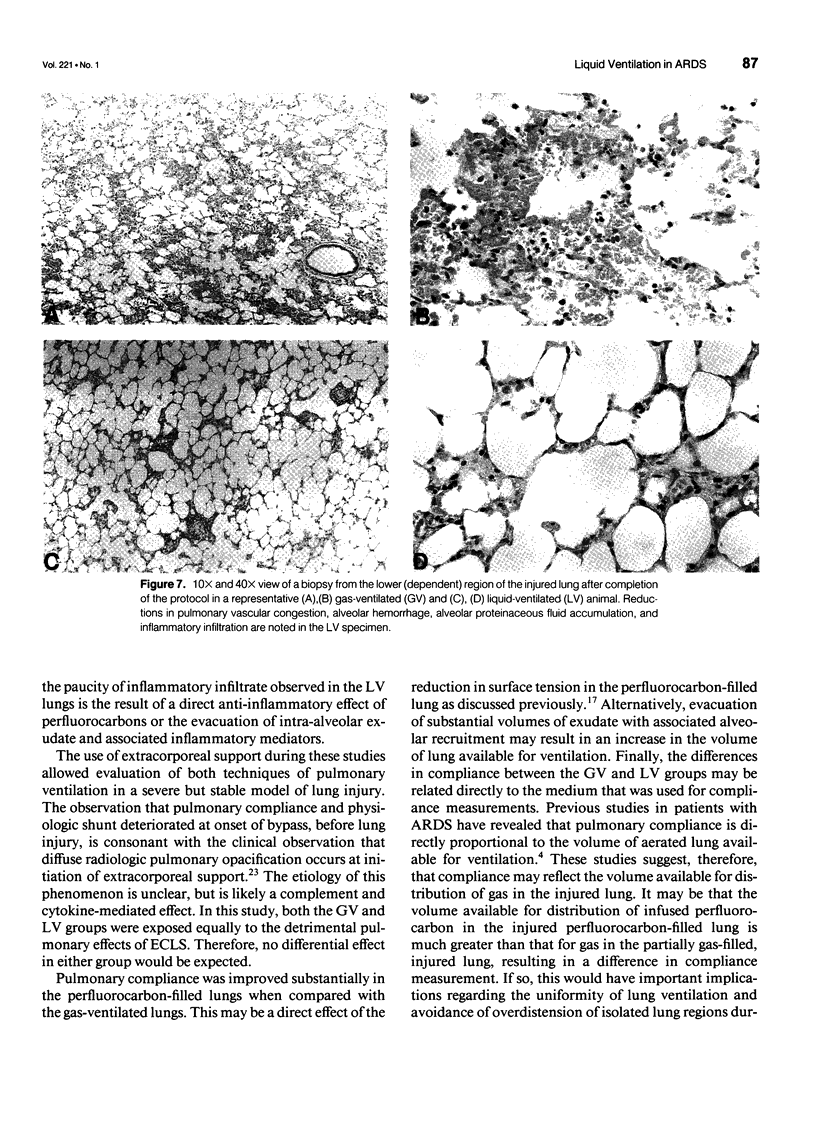
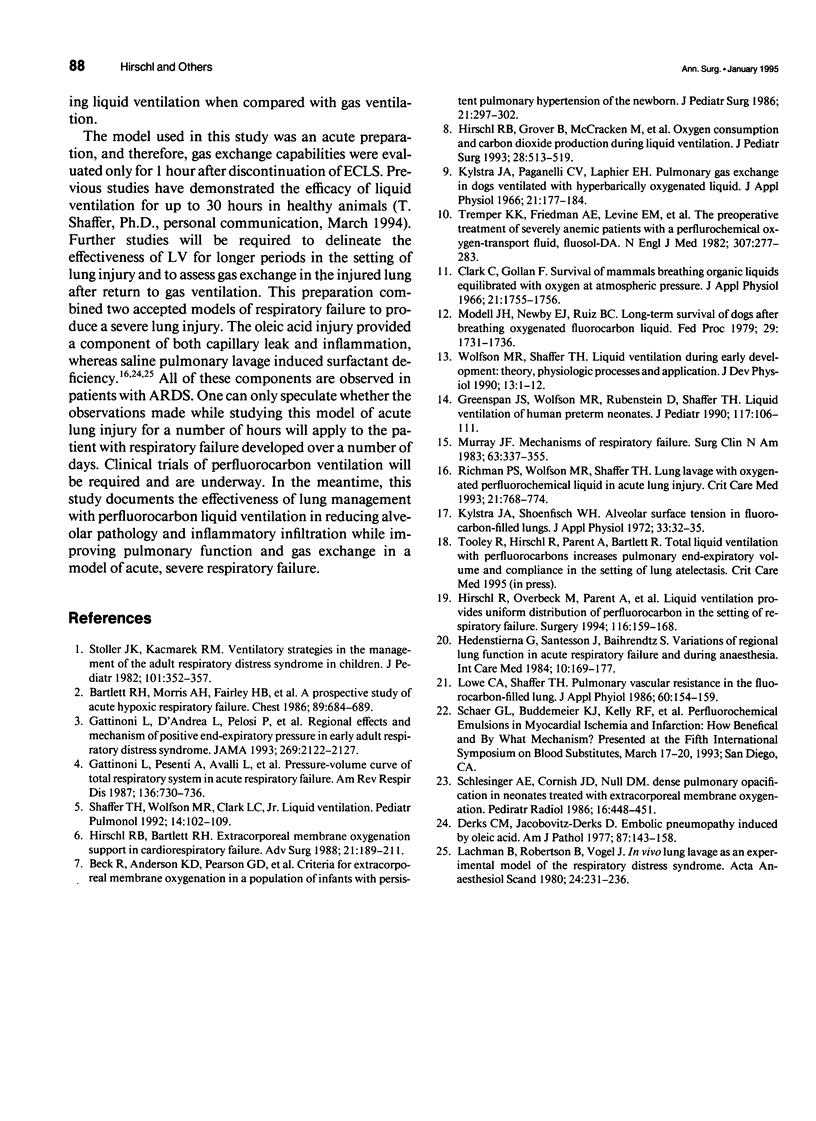
Images in this article
Selected References
These references are in PubMed. This may not be the complete list of references from this article.
- Bartlett R. H., Morris A. H., Fairley H. B., Hirsch R., O'Connor N., Pontoppidan H. A prospective study of acute hypoxic respiratory failure. Chest. 1986 May;89(5):684–689. doi: 10.1378/chest.89.5.684. [DOI] [PubMed] [Google Scholar]
- Beck R., Anderson K. D., Pearson G. D., Cronin J., Miller M. K., Short B. L. Criteria for extracorporeal membrane oxygenation in a population of infants with persistent pulmonary hypertension of the newborn. J Pediatr Surg. 1986 Apr;21(4):297–302. doi: 10.1016/s0022-3468(86)80188-9. [DOI] [PubMed] [Google Scholar]
- Clark L. C., Jr, Gollan F. Survival of mammals breathing organic liquids equilibrated with oxygen at atmospheric pressure. Science. 1966 Jun 24;152(3730):1755–1756. doi: 10.1126/science.152.3730.1755. [DOI] [PubMed] [Google Scholar]
- Demling R. H., Nerlich M. Acute respiratory failure. Surg Clin North Am. 1983 Apr;63(2):337–355. doi: 10.1016/s0039-6109(16)42985-3. [DOI] [PubMed] [Google Scholar]
- Derks C. M., Jacobovitz-Derks D. Embolic pneumopathy induced by oleic acid. A systematic morphologic study. Am J Pathol. 1977 Apr;87(1):143–158. [PMC free article] [PubMed] [Google Scholar]
- Gattinoni L., D'Andrea L., Pelosi P., Vitale G., Pesenti A., Fumagalli R. Regional effects and mechanism of positive end-expiratory pressure in early adult respiratory distress syndrome. JAMA. 1993 Apr 28;269(16):2122–2127. [PubMed] [Google Scholar]
- Gattinoni L., Pesenti A., Avalli L., Rossi F., Bombino M. Pressure-volume curve of total respiratory system in acute respiratory failure. Computed tomographic scan study. Am Rev Respir Dis. 1987 Sep;136(3):730–736. doi: 10.1164/ajrccm/136.3.730. [DOI] [PubMed] [Google Scholar]
- Greenspan J. S., Wolfson M. R., Rubenstein S. D., Shaffer T. H. Liquid ventilation of human preterm neonates. J Pediatr. 1990 Jul;117(1 Pt 1):106–111. doi: 10.1016/s0022-3476(05)82457-6. [DOI] [PubMed] [Google Scholar]
- Hedenstierna G., Santesson J., Baehrendtz S. Variations of regional lung function in acute respiratory failure and during anaesthesia. Intensive Care Med. 1984;10(4):169–177. doi: 10.1007/BF00259433. [DOI] [PubMed] [Google Scholar]
- Hirschl R. B., Bartlett R. H. Extracorporeal membrane oxygenation support in cardiorespiratory failure. Adv Surg. 1988;21:189–211. [PubMed] [Google Scholar]
- Hirschl R. B., Grover B., McCracken M., Wolfson M. R., Shaffer T. H., Bartlett R. H. Oxygen consumption and carbon dioxide production during liquid ventilation. J Pediatr Surg. 1993 Apr;28(4):513–519. doi: 10.1016/0022-3468(93)90608-n. [DOI] [PubMed] [Google Scholar]
- Hirschl R. B., Overbeck M. C., Parent A., Hernandez R., Schwartz S., Dosanjh A., Johnson K., Bartlett R. H. Liquid ventilation provides uniform distribution of perfluorocarbon in the setting of respiratory failure. Surgery. 1994 Aug;116(2):159–168. [PubMed] [Google Scholar]
- Kylstra J. A., Paganelli C. V., Lanphier E. H. Pulmonary gas exchange in dogs ventilated with hyperbarically oxygenated liquid. J Appl Physiol. 1966 Jan;21(1):177–184. doi: 10.1152/jappl.1966.21.1.177. [DOI] [PubMed] [Google Scholar]
- Kylstra J. A., Schoenfisch W. H. Alveolar surface tension in fluorocarbon-filled lungs. J Appl Physiol. 1972 Jul;33(1):32–35. doi: 10.1152/jappl.1972.33.1.32. [DOI] [PubMed] [Google Scholar]
- Lachmann B., Robertson B., Vogel J. In vivo lung lavage as an experimental model of the respiratory distress syndrome. Acta Anaesthesiol Scand. 1980 Jun;24(3):231–236. doi: 10.1111/j.1399-6576.1980.tb01541.x. [DOI] [PubMed] [Google Scholar]
- Lowe C. A., Shaffer T. H. Pulmonary vascular resistance in the fluorocarbon-filled lung. J Appl Physiol (1985) 1986 Jan;60(1):154–159. doi: 10.1152/jappl.1986.60.1.154. [DOI] [PubMed] [Google Scholar]
- Modell J. H., Newby E. J., Ruiz B. C. Long-term survival of dogs after breathing oxygenated fluorocarbon liquid. Fed Proc. 1970 Sep-Oct;29(5):1731–1736. [PubMed] [Google Scholar]
- Pfenninger J., Gerber A., Tschäppeler H., Zimmermann A. Adult respiratory distress syndrome in children. J Pediatr. 1982 Sep;101(3):352–357. doi: 10.1016/s0022-3476(82)80057-7. [DOI] [PubMed] [Google Scholar]
- Richman P. S., Wolfson M. R., Shaffer T. H. Lung lavage with oxygenated perfluorochemical liquid in acute lung injury. Crit Care Med. 1993 May;21(5):768–774. doi: 10.1097/00003246-199305000-00022. [DOI] [PubMed] [Google Scholar]
- Schlesinger A. E., Cornish J. D., Null D. M. Dense pulmonary opacification in neonates treated with extracorporeal membrane oxygenation. Pediatr Radiol. 1986;16(6):448–451. doi: 10.1007/BF02387954. [DOI] [PubMed] [Google Scholar]
- Shaffer T. H., Wolfson M. R., Clark L. C., Jr Liquid ventilation. Pediatr Pulmonol. 1992 Oct;14(2):102–109. doi: 10.1002/ppul.1950140208. [DOI] [PubMed] [Google Scholar]
- Tremper K. K., Friedman A. E., Levine E. M., Lapin R., Camarillo D. The preoperative treatment of severely anemic patients with a perfluorochemical oxygen-transport fluid, Fluosol-DA. N Engl J Med. 1982 Jul 29;307(5):277–283. doi: 10.1056/NEJM198207293070503. [DOI] [PubMed] [Google Scholar]
- Wolfson M. R., Shaffer T. H. Liquid ventilation during early development: theory, physiologic processes and application. J Dev Physiol. 1990 Jan;13(1):1–12. [PubMed] [Google Scholar]




